
Can you use Castor Oil when you have a cold or the flu?
Written by: Heather Tanti, R.P.N (non-practicing)
Reviewed by: Melanie Swackhammer, B.A
Est. reading time: 16 minutes
We’ve all been there. You go to bed fine, only to wake up with that tingle in your nose, and a dryness in your throat that you can’t seem to shake no matter how much water you drink. You climb out of bed, your body feeling achy and tired, and you wonder how you’re going to make it through the day.
Your morning is spent blowing your nose, clearing your throat, and searching for the nearest cold and flu medication to help bring you some relief. Can you relate? Having a cold and flu is no picnic, and can make your body feel completely run down.
Perhaps you’ve tried home remedies before, like the popular vicks vapor rub on your feet, or the drink known as a ‘hot tamale’, meant to help clear your sinuses, right? But, maybe you’re wondering… can you use Castor Oil when you have a cold or the flu?
Let’s dig deeper into how this natural oil and the simple act of wearing a Castor Oil Pack may be a support.
The difference between cold and flu
Have you ever wondered what the difference is between a cold and a flu? It’s okay if you have, sometimes it can be hard to distinguish as symptoms can overlap.
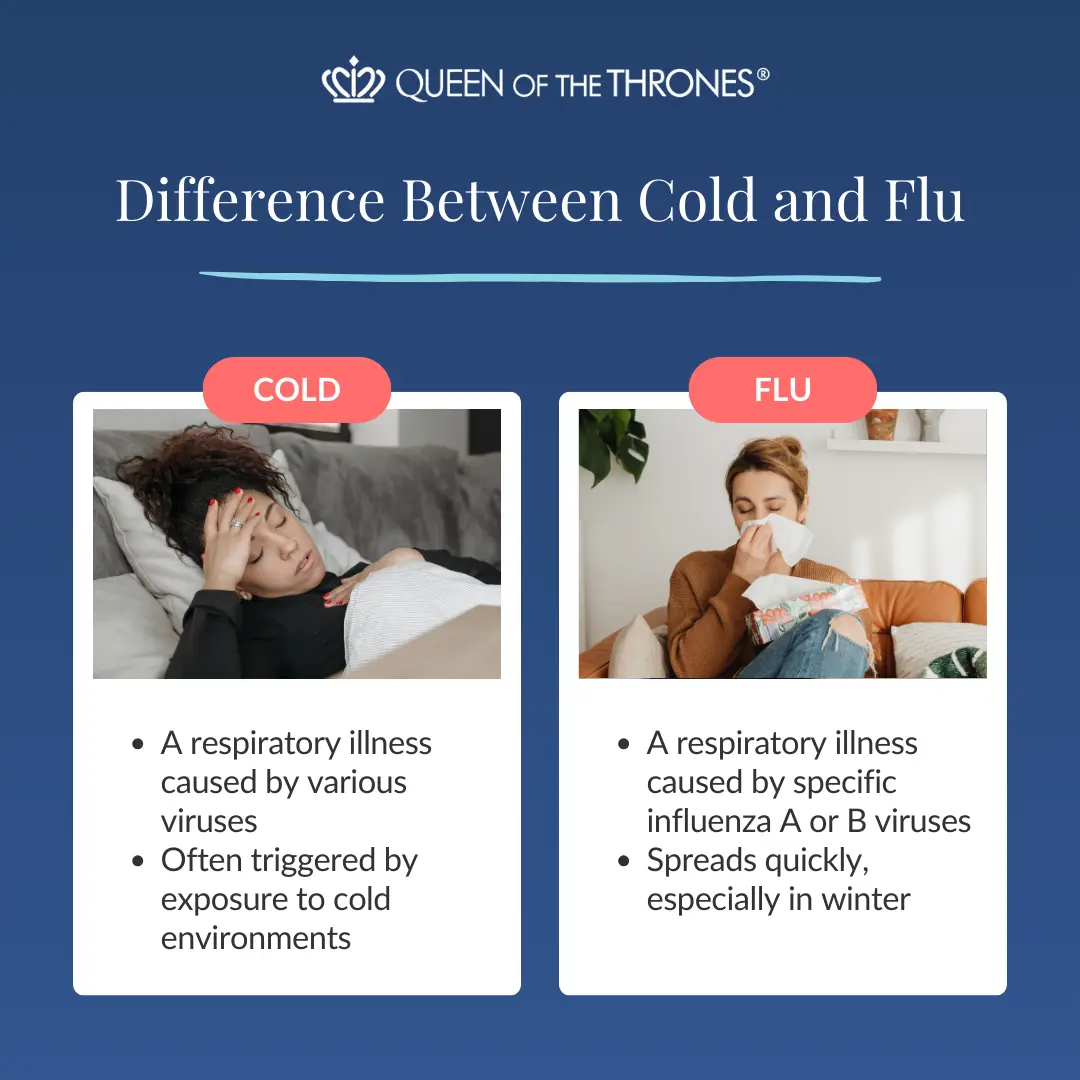
Cold viruses like it when it’s a bit cold and dry. The first sign of a cold is usually a runny nose, followed by a sore throat and maybe a fever. Luckily, most cold symptoms go away within 3 days, and at the longest, they last around 5 to 7 days.1
However, Influenza, commonly known as the flu, is a quick-spreading illness caused by influenza A or B viruses. It tends to happen a lot in the winter and can affect many people at once. The virus is found in the respiratory secretions of infected people and spreads when they cough or sneeze. The flu usually lasts around 5 days in healthy adults but can linger for up to 10 days or more, especially in kids, older adults, those with chronic illnesses, and people with weakened immune systems.
When someone gets the flu, it starts suddenly with a high fever, muscle aches, headache, and feeling really tired. Respiratory symptoms like cough, sore throat, and runny nose also show up. In some cases, the flu can affect other organs like the lungs, brain, and heart, leading to serious complications and hospitalization.2
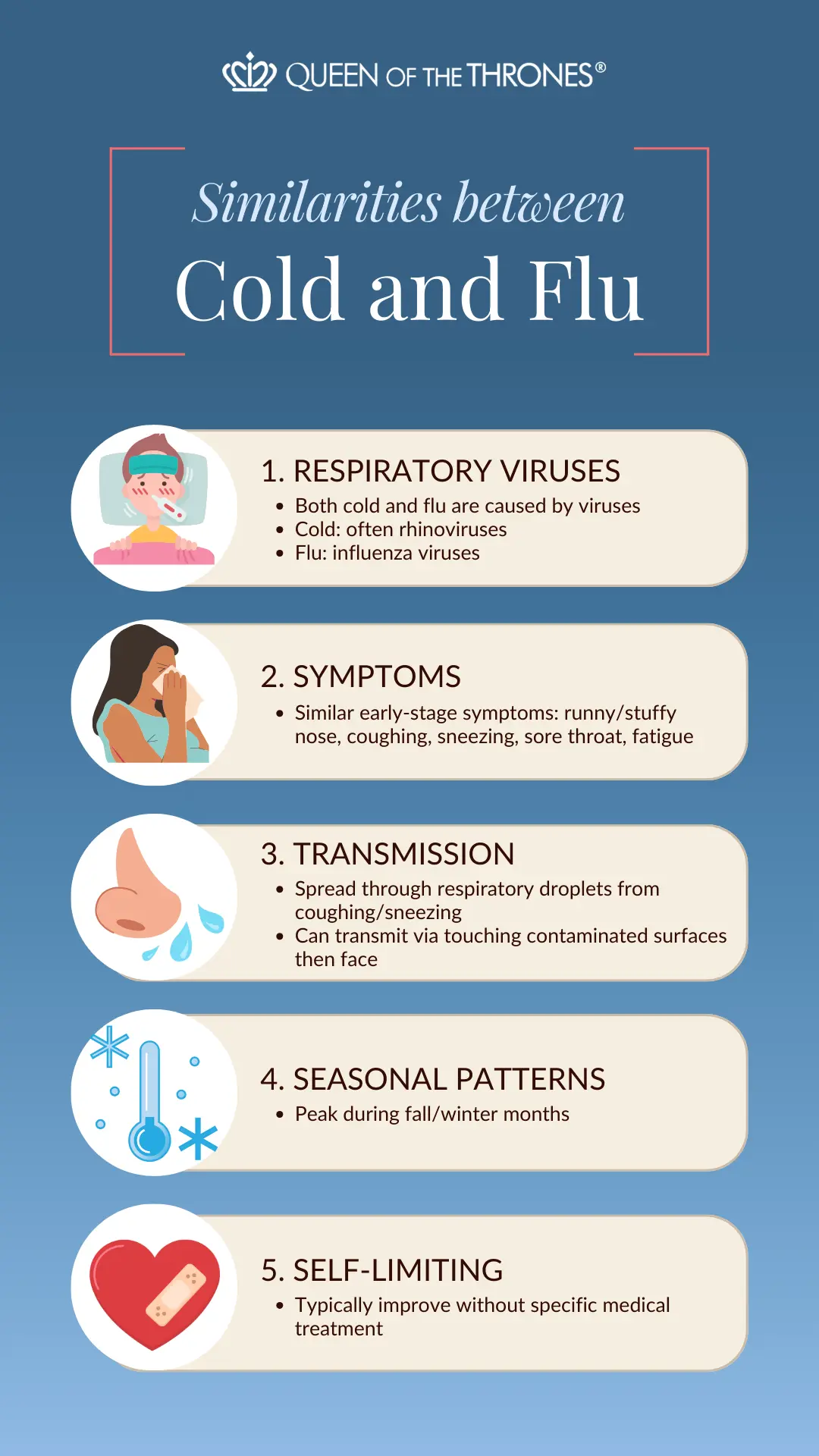
The cold and flu, or influenza, share several similarities:
1. Respiratory Viruses: Both the common cold and the flu are caused by viruses. The cold is often caused by rhinoviruses, while the flu is caused by influenza viruses.
2. Symptoms: They both present with similar symptoms, especially in the early stages. These symptoms include a runny or stuffy nose, coughing, sneezing, sore throat, and fatigue.
3. Transmission: Both illnesses spread through respiratory droplets produced when an infected person coughs or sneezes. Additionally, they can be transmitted by touching a surface or object with the virus on it and then touching the face.
4. Seasonal Patterns: Cold and flu viruses often peak during specific seasons, with a higher incidence during the fall and winter months.
5. Self-Limiting: In most cases, both the common cold and the flu are self-limiting illnesses, meaning they usually get better on their own without specific medical treatment.
Despite these similarities, it’s important to note that the viruses causing the cold and flu are different, and the flu tends to be more severe and can lead to more serious complications.
Cold and flu symptoms
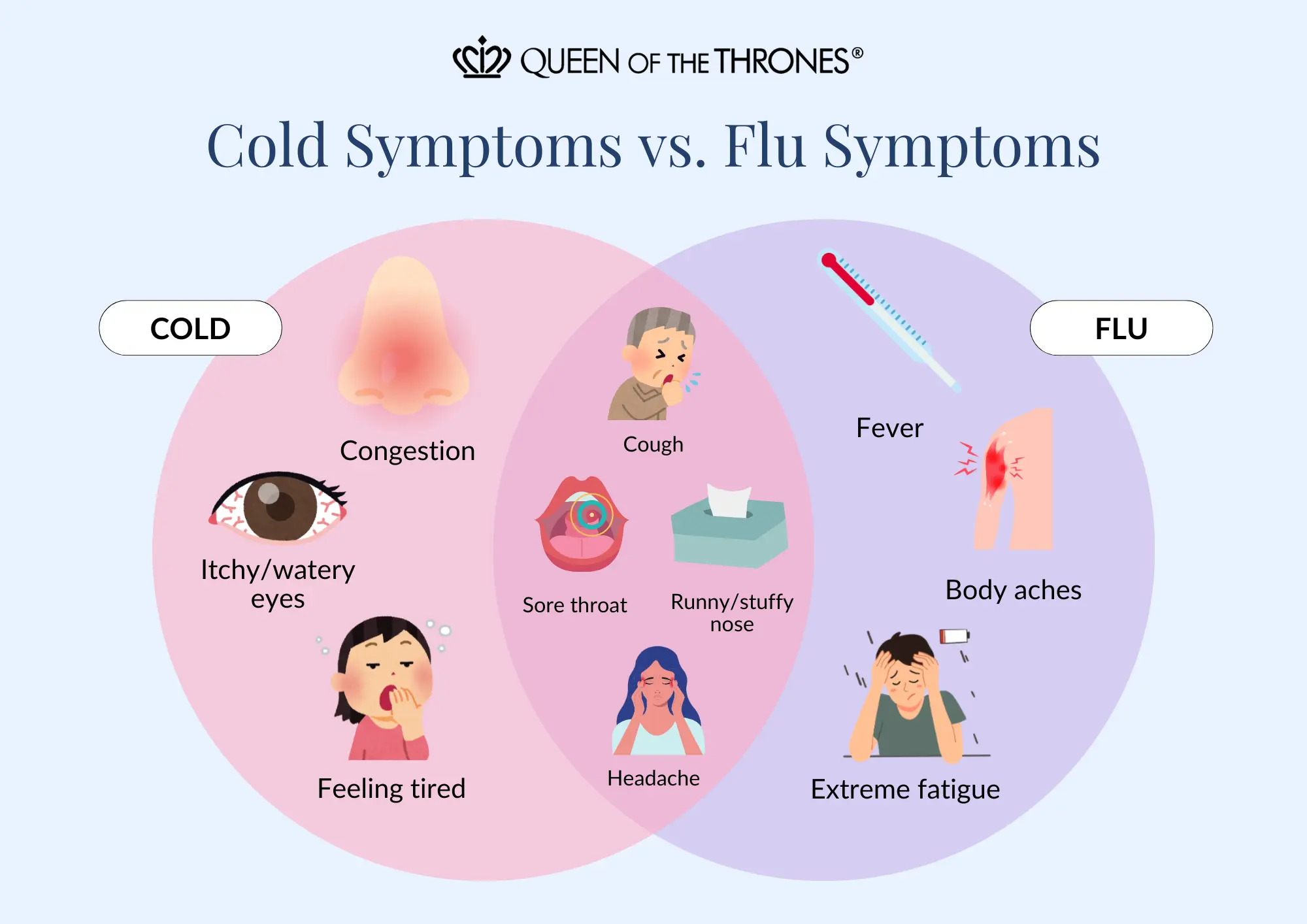
It’s like your body’s way of saying, “Hey, I’m not feeling great right now.” And just like when you catch a cold, the flu also makes you want to stay in bed and take it easy.
The good news is that most of the time, both the cold and the flu go away on their own.3
Cold headaches
When you have a cold, your body is responding to the viral invasion by mounting an immune response. Part of this defense involves the release of certain chemicals, such as cytokines, to combat the virus. However, these chemicals can also affect the blood vessels in your head.4
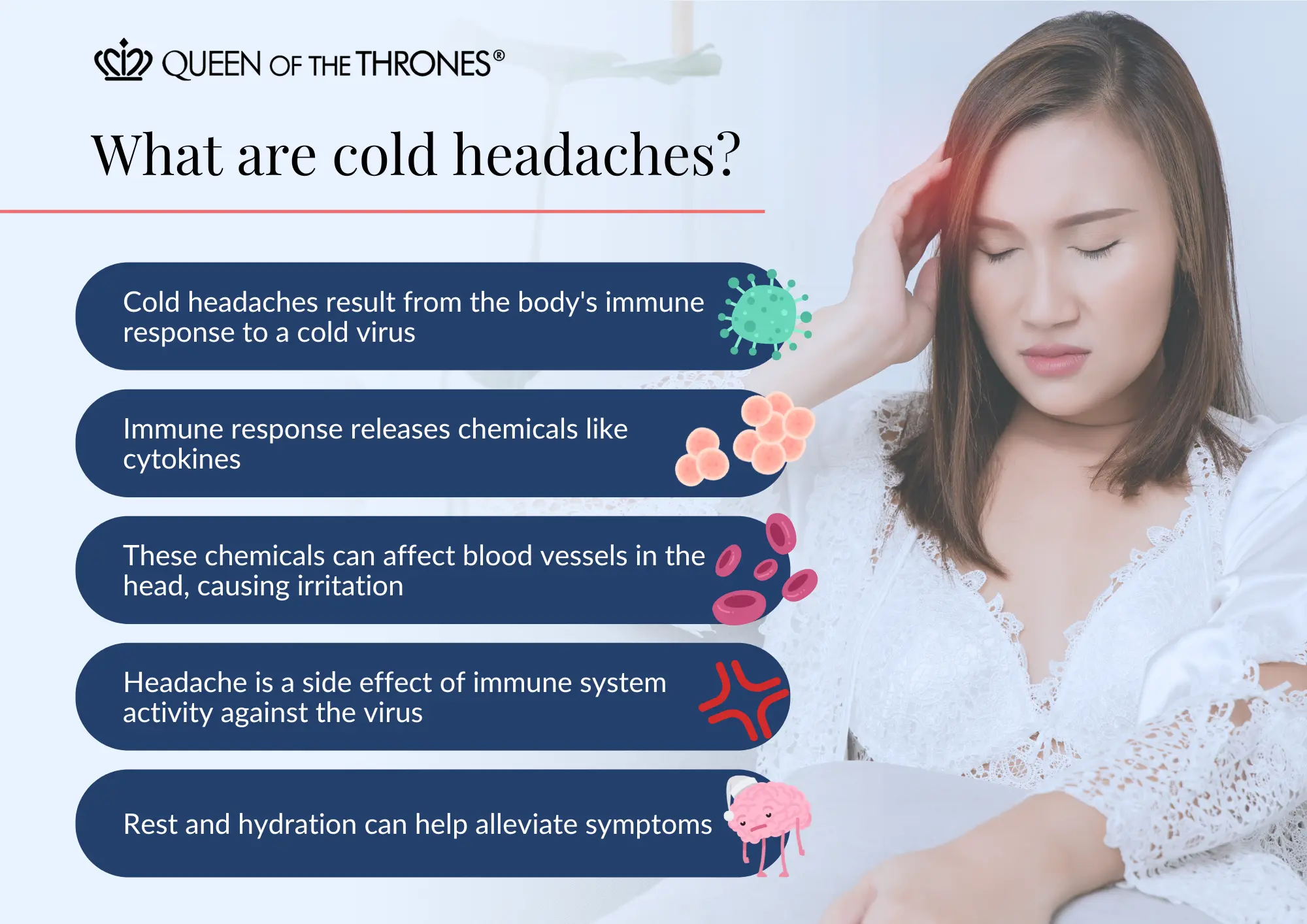
Think of it as your body’s way of deploying troops to fight off the cold virus. In the process, the communication between these troops (immune cells) and the blood vessels can cause some irritation, leading to a headache. It’s a side effect of the immune response, indicating that your body is actively working to fend off the viral intruders.
While the headache can be uncomfortable, it’s a sign that your immune system is engaged in the battle against the cold. Taking measures to rest and stay hydrated can support your body in its efforts to recover.
Runny nose and congestion
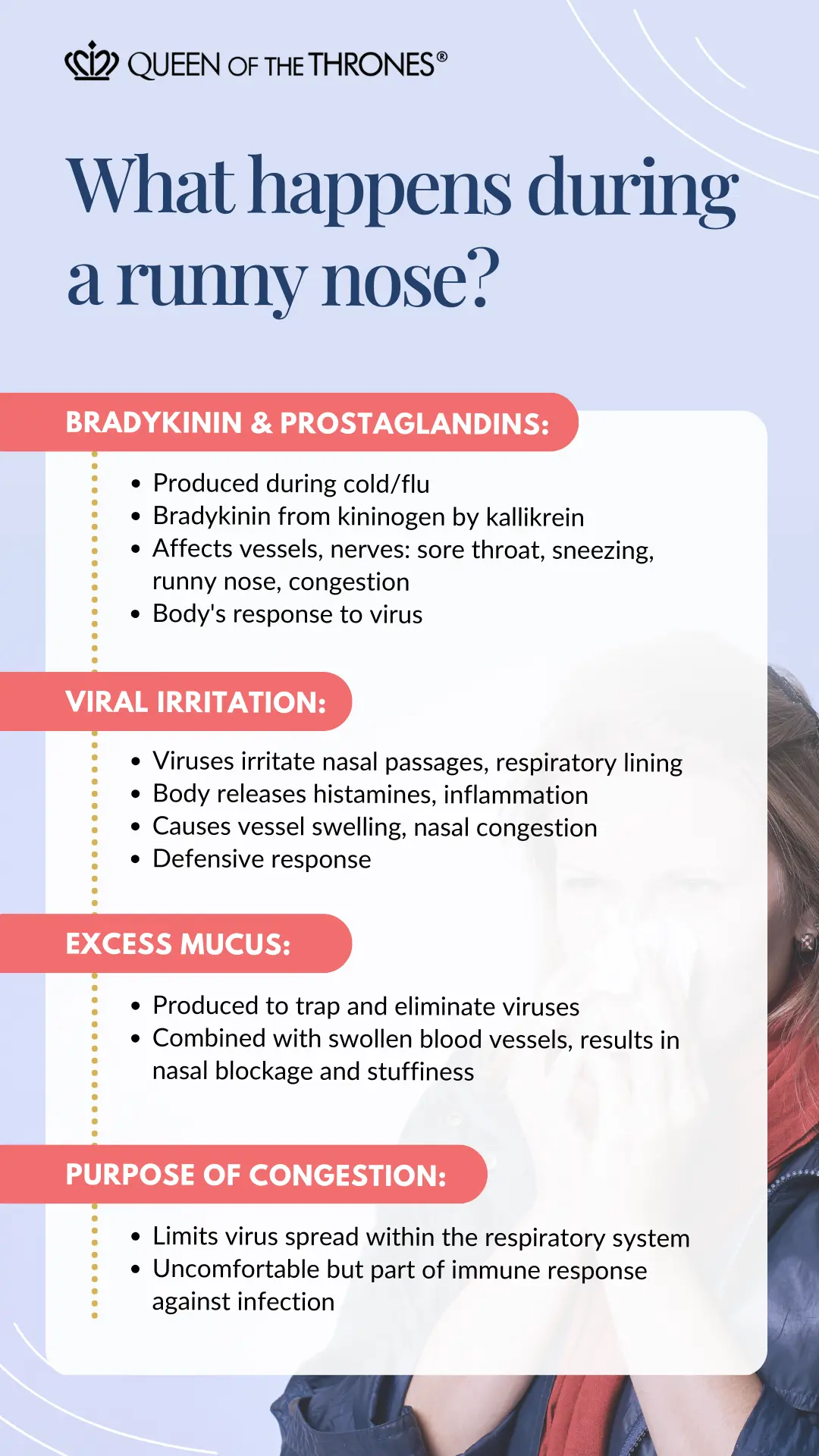
In a common cold or flu, there are substances called bradykinin and prostaglandins that play a role in making you feel stuffy and having a runny nose. Bradykinin is produced when a special enzyme called kallikrein is released from cells in your nose. This enzyme changes another substance, kininogen, into bradykinin. Bradykinin can affect your blood vessels and nerves, causing things like a sore throat, sneezing, a runny nose, and congestion in your nose. It’s like your body’s way of responding to the virus and trying to get rid of it.5
The viruses responsible for colds and the flu can irritate the lining of your nasal passages and respiratory system. In response to this irritation, your body releases substances like histamines and inflammatory chemicals. These substances cause the blood vessels in your nasal tissues to swell (dilate), leading to congestion.6
Additionally, your body produces more mucus to trap and eliminate the viruses. This excess mucus, combined with the swollen blood vessels, can make your nasal passages feel blocked and stuffy.
So, congestion is essentially your body’s way of trying to protect itself by limiting the virus’s ability to spread deeper into your respiratory system. While it might be uncomfortable, this response is part of your immune system’s efforts to fight off the infection.
Sore throat and fever
Probably two of the most frustrating symptoms of a cold and flu is the persistent sore throat and fever. These two symptoms can really put a damper on how you feel, and make your basic day-to-day activities feel near impossible.
When you catch a cold or the flu, experiencing a sore throat and fever is a common part of your body’s response to the viral infection. The viruses responsible for these illnesses can irritate and infect the tissues in your throat, leading to discomfort and a sore feeling. In addition, your body initiates an immune response, releasing chemicals like cytokines, which contribute to inflammation and further contribute to the sore throat sensation.7
As for the fever, it serves as a strategic response to the viral invasion. By elevating your body temperature, viruses find it more challenging to replicate and spread. Essentially, a fever creates an environment less favorable for the virus, aiding your immune system in its efforts to combat the infection.8
While these symptoms can be unpleasant, they are indicative of your body actively working to fend off the viral intruders. Managing symptoms through rest, hydration, and appropriate medications can help support your body’s natural defenses during this time.
Home remedies for cold and flu
Most of us have taken standard cold and flu medications when trying to combat the irritating symptoms that wreak havoc on our body, but what about home remedies? Let’s look at a few that have been used when navigating cold and flu symptoms.
Wet/cold sock treatment
This treatment or home remedy may seem odd, afterall, placing ice cold socks on your feet when struggling with a cold or flu hardly seems comfortable, right? But stay with me, let’s explore the method behind this home remedy.
The wet/cold sock treatment is considered a home remedy for colds and flu, and it is believed to work by enhancing circulation and supporting the immune system.
After a warm bath, the method involves putting on a thin pair of cotton socks that have been soaked in ice water and then wrung out. Over these wet socks, a second pair of dry wool socks is worn. This process is thought to stimulate circulation and promote the body’s natural immune response.
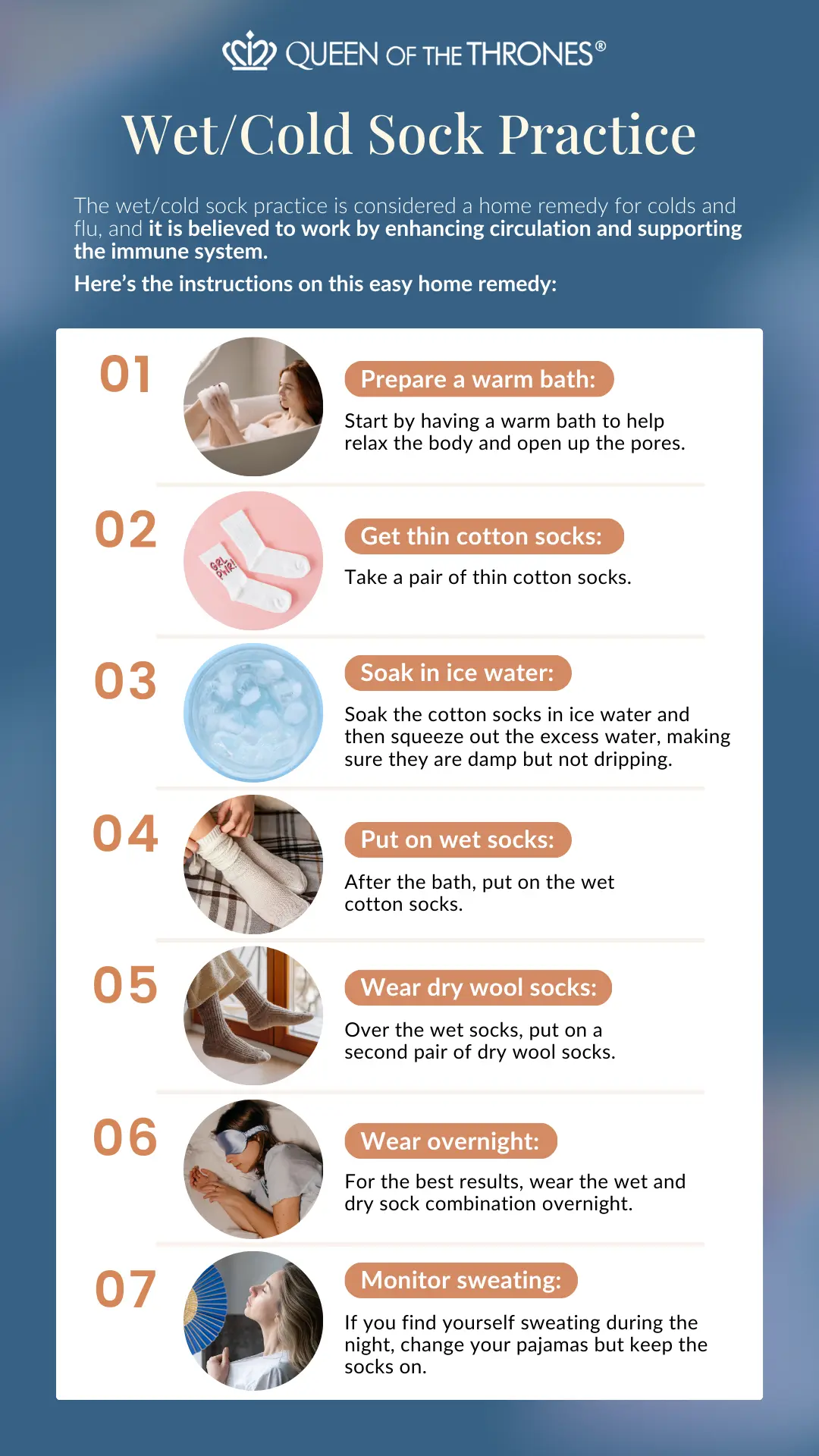
Here’s the instructions on this easy home remedy:
1. Prepare a warm bath: Start by having a warm bath to help relax the body and open up the pores.
2. Get thin cotton socks: Take a pair of thin cotton socks.
3. Soak in ice water: Soak the cotton socks in ice water and then squeeze out the excess water, making sure they are damp but not dripping.
4. Put on wet socks: After the bath, put on the wet cotton socks.
5. Wear dry wool socks: Over the wet socks, put on a second pair of dry wool socks.
6. Wear overnight: For the best results, wear the wet and dry sock combination overnight.
7. Monitor sweating: If you find yourself sweating during the night, change your pajamas but keep the socks on.
Wearing the wet socks overnight, especially during a fever, allows the body to adapt to the temperature difference. As the body works to warm up the wet socks, it may increase blood flow and circulation. By morning, the socks are expected to be dry, indicating that the treatment has had an impact.
It’s important to note that this remedy is often used with children, and if they sweat overnight, changing their pajamas while keeping the socks on may help. It’s important to keep in mind that the effectiveness of this method is anecdotal and may vary from person to person.
Natural chest rub
In clinical trials, evaluating the effectiveness of an ointment containing menthol, eucalyptus, and camphor, participants demonstrated quicker nasal cooling and decongestion. Additionally, the use of these ointments led to a notable difference in reported sleep quality.10
What makes menthol, eucalyptus, and camphor so beneficial? Let’s discuss!
Menthol: Menthol, found in things like cough drops, nasal sprays, and vapor rubs, is commonly used to help with a stuffy or runny nose caused by colds or allergies. It’s been used in traditional Asian medicine for a long time to treat respiratory issues. In the West, it became a recognized medicine in the late 19th century. Now, we know that menthol works by interacting with a specific receptor on our nerves, creating a cool sensation. So, it’s not just an old remedy—it’s got some modern science behind it too!11
Eucalyptus: Eucalyptus oil is mainly used to treat coughs, colds, bronchitis, and to provide relief from symptoms associated with upper respiratory tract colds. Eucalyptus is useful for treating various respiratory problems due to its many effects, such as fighting bacteria, viruses, reducing inflammation, thinning mucus, and opening up the airways.12
Camphor: Using camphor on the skin has been believed to help with blood circulation, but we don’t fully understand how it affects blood flow to the skin and our sense of temperature.13 When used, it may help relieve nasal congestion by opening up the airways, making breathing more comfortable during periods of a stuffy nose.
Additionally, camphor is often included in cough remedies, where it is believed to have a soothing effect on the throat and may suppress cough reflexes. Its anti-inflammatory properties may contribute to reducing inflammation in the respiratory tract, providing relief from symptoms like sore throat and irritation14
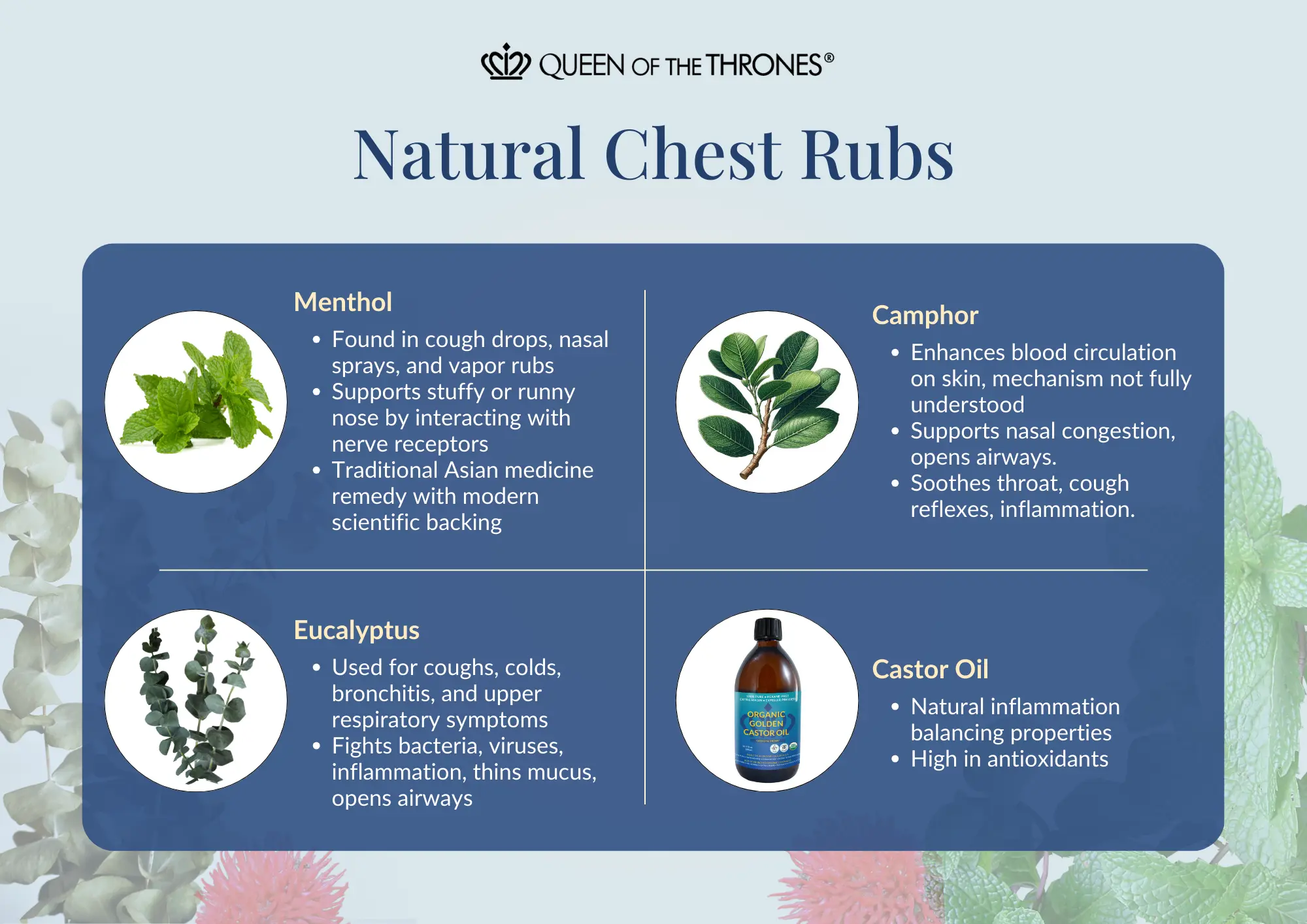
Castor Oil and Colds
The plant contains different natural compounds that are thought to have medicinal properties that may support balancing inflammation, and even exhibits antioxidant activity.15
But, can you use Castor Oil when you have a cold or the flu?
While Castor Oil is not typically recognized as having a direct connection between supporting cold-like symptoms, we can look at what Castor Oil is most recognized for.
Anti-Inflammatory Properties: Castor Oil contains ricinoleic acid, which has demonstrated anti-inflammatory effects.16 You see, research shows that inflammation is the root cause to dis-ease within the body, meaning inflammation may be a common response to infections, including those causing cold and flu symptoms. So, it could be said that Castor Oil may be able to support balancing the inflammation that’s naturally happening when you’re feeling under the weather.
So, applying Castor Oil on the chest or throat may help. Alternatively, wearing a Castor Oil Pack over your neck/thyroid, may be an easy way to care for your throat. More on this soon!
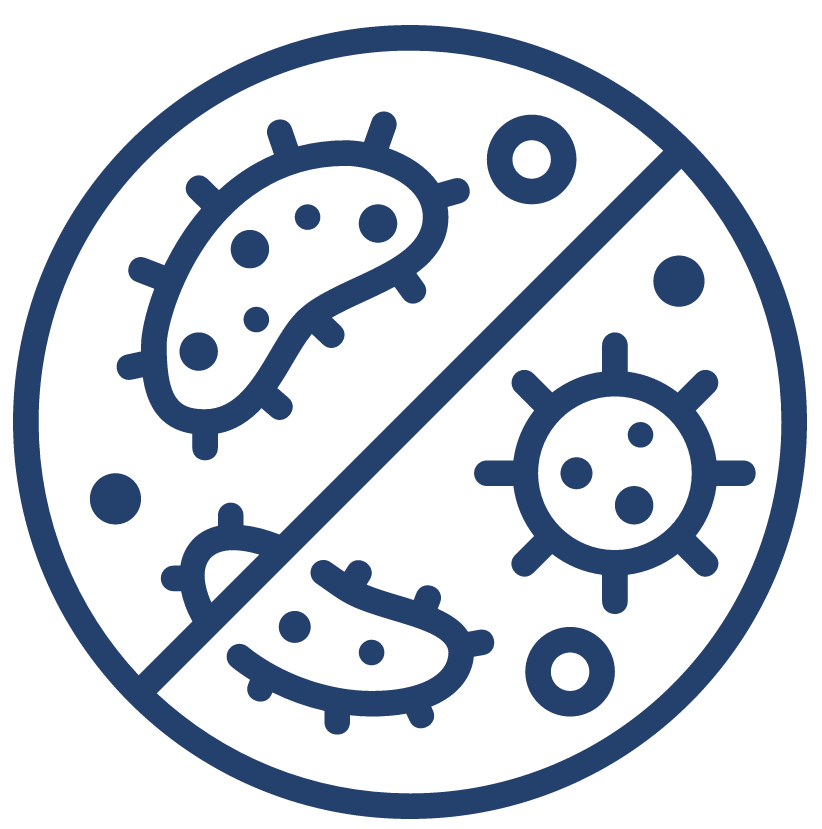
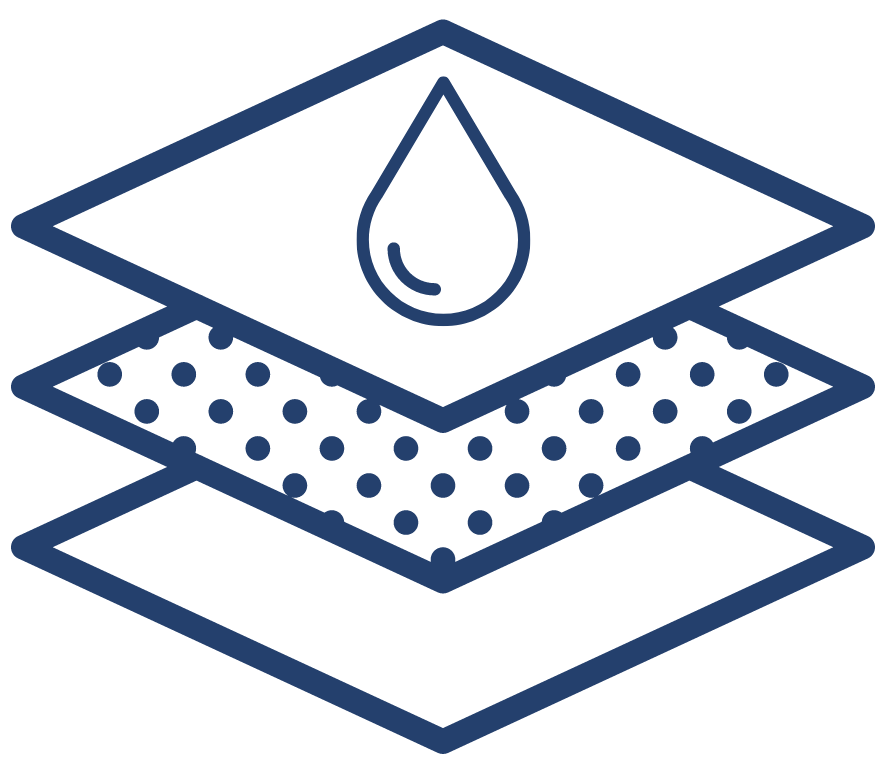
Pretty amazing, agreed? But remember, not all Castor Oil is created equally.
When it comes to your wellness, you want to ensure you’re sourcing Castor Oil that is 100% pure, organic and hexane free, like Queen of the Thrones® Castor Oil.
Castor Oil Packs Made Easy
A Castor Oil Pack is a traditional practice that involves the topical application of Castor Oil to the skin. The pack is typically made by saturating a piece of cloth (such as flannel) with Castor Oil and then placing it on the skin.
However, this old way of doing Castor Oil Packs has been known to be messy, inconvenient and not very ideal. Thankfully, this ancient practice has been revitalized to be less-mess, heat-less and easy to do.
Queen of the Thrones® Castor Oil Packs have been designed by a Naturopathic Doctor to bring you an easy way to support your body from the outside in with Castor Oil, while ensuring the pack is always:
✓ Organic cotton. The inner layer of cotton flannel that comes in direct contact with your skin is organic, natural, and free from bleaching agents, ensuring there is no greenwashing involved.
✓ Less mess layer. The external “less mess” layer is made of polypropylene, thermally bonded (a cleaner alternative to chemical bonding), and coupled with an extra layer of organic cotton. This material is commonly used in food-safe containers, such as yogurt cups. Please be aware that while this pack is less messy, it is not entirely messless, as Castor Oil may stain fabrics. Always wear an old T-shirt as a precaution.
✓ Adjustable straps. The pack features soft and stretchy nylon straps that are adjustable to accommodate the liver area for most body sizes.
Castor Oil Packs for Immune Support
And as for colds, the inflammation that can be felt in the nose, throat and chest can really make you feel run down. Like we discussed before with Castor Oil’s anti-inflammatory properties, adding a Castor Oil Pack to your Castor Oil practice may help balance that inflammation.21
Plus, the compression of a Castor Oil Pack is thought to help with lymphatic drainage,22 which may ease congestion and blockages within your body by enhancing circulation to the affected areas via the release of nitric oxide from Castor Oil.23
The best part about Castor Oil Packs is that they’re so versatile. While Castor Oil Packs worn over the liver are quite common, you can also wear a Castor Oil Pack over your neck so you can support your throat if you’ve adopted the practice of applying Castor Oil to your neck area.
Additionally, Castor Oil Packs are thought to support liver function,24 which may potentially help flush out toxins. You see, the liver is the hub of detoxification, and when you support it with gentle practices like the Castor Oil Pack, it is thought to help your body’s processes and systems to help flush out toxins easier.
Sounds wonderful, right? Discover more about how Castor Oil Packs work in the free eGuide below!
Conclusion
In conclusion, if you’re wondering if you can use Castor Oil when you have a cold or the flu, as well as Castor Oil Packs, rest assured that they are supportive for your self-care, but have not yet been documented in scientific literature.
That being said, we can look at the research that speaks to the anti-inflammatory, antimicrobial, and skin-soothing properties of Castor Oil. This is because Castor Oil and Castor Oil Packs are a holistic approach to self-care that offers support from the outside in.
Are you a practitioner, health coach or wellness influencer? If you’re interested in recommending our easy-to-use tools and practically applying them in your health and wellness professional practice, in clinic, or online with the people you serve, you can join now!
Click here for references
1.Lee WJ. Common Cold and Flu. Vitamin C in Human Health and Disease. 2019 Aug 7:89–100. doi: 10.1007/978-94-024-1713-5_5. PMCID: PMC7122289.
- Moghadami M. A Narrative Review of Influenza: A Seasonal and Pandemic Disease. Iran J Med Sci. 2017 Jan;42(1):2-13. PMID: 28293045; PMCID: PMC5337761.
- Kirkpatrick GL. The common cold. Prim Care. 1996 Dec;23(4):657-75. doi: 10.1016/s0095-4543(05)70355-9. PMID: 8890137; PMCID: PMC7125839.
- Thuraiaiyah J, Erritzøe-Jervild M, Al-Khazali HM, Schytz HW, Younis S. The role of cytokines in migraine: A systematic review. Cephalalgia. 2022 Dec;42(14):1565-1588. doi: 10.1177/03331024221118924. Epub 2022 Aug 12. PMID: 35962530.
- Eccles R. Common cold. Front Allergy. 2023 Jun 22;4:1224988. doi: 10.3389/falgy.2023.1224988. PMID: 37426629; PMCID: PMC10324571.
- Kirkpatrick GL. The common cold. Prim Care. 1996 Dec;23(4):657-75. doi: 10.1016/s0095-4543(05)70355-9. PMID: 8890137; PMCID: PMC7125839.
- Wine TM, Alper CM. Cytokine responses in the common cold and otitis media. Curr Allergy Asthma Rep. 2012 Dec;12(6):574-81. doi: 10.1007/s11882-012-0306-z. PMID: 23054624; PMCID: PMC7089162.
- Belon L, Skidmore P, Mehra R, Walter E. Effect of a fever in viral infections – the ‘Goldilocks’ phenomenon? World J Clin Cases. 2021 Jan 16;9(2):296-307. doi: 10.12998/wjcc.v9.i2.296. PMID: 33521098; PMCID: PMC7812885.
9. Zimmerman RK, Balasubramani GK, D’Agostino HEA, Clarke L, Yassin M, Middleton DB, Silveira FP, Wheeler ND, Landis J, Peterson A, Suyama J, Weissman A, Nowalk MP. Population-based hospitalization burden estimates for respiratory viruses, 2015-2019. Influenza Other Respir Viruses. 2022 Nov;16(6):1133-1140. doi: 10.1111/irv.13040. Epub 2022 Aug 22. PMID: 35996836; PMCID: PMC9530548.
- Smith A, Matthews O. Aromatic ointments for the common cold: what does the science say? Drugs Context. 2022 Aug 1;11:2022-5-6. doi: 10.7573/dic.2022-5-6. PMID: 35975030; PMCID: PMC9354706.
- Eccles R. Menthol: effects on nasal sensation of airflow and the drive to breathe. Curr Allergy Asthma Rep. 2003 May;3(3):210-4. doi: 10.1007/s11882-003-0041-6. PMID: 12662469.
- Yadav N, Chandra H. Suppression of inflammatory and infection responses in lung macrophages by eucalyptus oil and its constituent 1,8-cineole: Role of pattern recognition receptors TREM-1 and NLRP3, the MAP kinase regulator MKP-1, and NFκB. PLoS One. 2017 Nov 15;12(11):e0188232. doi: 10.1371/journal.pone.0188232. PMID: 29141025; PMCID: PMC5687727.
- Kotaka T, Kimura S, Kashiwayanagi M, Iwamoto J. Camphor induces cold and warm sensations with increases in skin and muscle blood flow in human. Biol Pharm Bull. 2014;37(12):1913-8. doi: 10.1248/bpb.b14-00442. PMID: 25451841.
- Hoang D, Wong A, Olympia RP. Looking Back to Move Forward: The Current State of Research on the Clinical Applications of Camphor- and Menthol-Containing Agents. Cureus. 2023 Jul 5;15(7):e41426. doi: 10.7759/cureus.41426. PMID: 37546095; PMCID: PMC10403385.
- Elkousy RH, Said ZNA, Abd El-Baseer MA, Abu El Wafa SA. Antiviral activity of castor oil plant (Ricinus communis) leaf extracts. J Ethnopharmacol. 2021 May 10;271:113878. doi: 10.1016/j.jep.2021.113878. Epub 2021 Jan 27. PMID: 33515683.
- Vieira C et al. .Effect of ricinoleic acid in acute and subchronic experimental models of inflammation. Mediators Inflamm. 2000;9(5):223-8 PMID: 11200362
- Al-Mamun MA, Akter Z, Uddin MJ, Ferdaus KM, Hoque KM, Ferdousi Z, Reza MA. Characterization and evaluation of antibacterial and antiproliferative activities of crude protein extracts isolated from the seed of Ricinus communis in Bangladesh. BMC Complement Altern Med. 2016 Jul 12;16:211. doi: 10.1186/s12906-016-1185-y. PMID: 27405609; PMCID: PMC4942971.
- Elkousy RH, Said ZNA, Abd El-Baseer MA, Abu El Wafa SA. Antiviral activity of castor oil plant (Ricinus communis) leaf extracts. J Ethnopharmacol. 2021 May 10;271:113878. doi: 10.1016/j.jep.2021.113878. Epub 2021 Jan 27. PMID: 33515683.
- Purnamawati S, Indrastuti N, Danarti R, Saefudin T. The Role of Moisturizers in Addressing Various Kinds of Dermatitis: A Review. Clin Med Res. 2017 Dec;15(3-4):75-87. doi: 10.3121/cmr.2017.1363. Epub 2017 Dec 11. PMID: 29229630; PMCID: PMC5849435.
- Arslan GG, Eşer I. An examination of the effect of castor oil packs on constipation in the elderly. Complement Ther Clin Pract. 2011 Feb;17(1):58-62. doi: 10.1016/j.ctcp.2010.04.004. Epub 2010 May 18. PMID: 21168117
20A. Tunaru S, Althoff TF, Nüsing RM, Diener M, Offermanns S. Castor oil induces laxation and uterus contraction via ricinoleic acid activating prostaglandin EP3 receptors. Proc Natl Acad Sci U S A. 2012 Jun 5;109(23):9179-84. doi: 10.1073/pnas.1201627109. Epub 2012 May 21. PMID: 22615395; PMCID: PMC3384204.
- Boddu SH1, Alsaab H2, Umar S3, Bonam SP2, Gupta H2, Ahmed S3. Anti-inflammatory effects of a novel ricinoleic acid poloxamer gel system for transdermal delivery. Int J Pharm. 2015 Feb 1;479(1):207-11. doi: 10.1016/j.ijpharm.2014.12.051. Epub 2014 Dec 24. PMID: 25542985
- Moore JE Jr, Bertram CD. Lymphatic System Flows. Annu Rev Fluid Mech. 2018 Jan;50:459-482. doi: 10.1146/annurev-fluid-122316-045259. PMID: 29713107; PMCID: PMC5922450
- Mascolo N, Izzo AA, Autore G, Barbato F, Capasso F. Nitric oxide and castor oil-induced diarrhea. J Pharmacol Exp Ther. 1994 Jan;268(1):291-5. PMID: 8301570.
- DA Kennedy, D Keaton Evidence for the Topical Application of Castor Oil: A Systematic Review.l International Journal of Naturopathic Medicine March 13, 2012 · Volume 5 https://intjnm.com/evidence-for-the-topical-application-of-castor-oil/



0 Comments